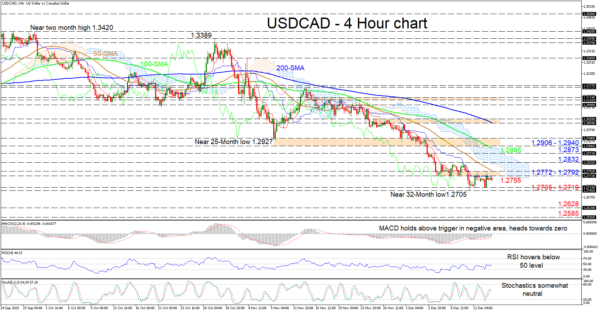USDCAD appears to have become moderately static after logging a near 32-month low of 1.2705 and forming a base around the 1.2700 handle. The flattening Ichimoku lines are backing this minor pause in the downside scenario, reflecting a condition of paused directional momentum. However, the pair’s predominant bearish tone continues to be aided by the downward sloping simple moving averages (SMAs).
The short-term oscillators also display a conflicting picture in momentum. The MACD, in the negative region, is above its red trigger line and is creeping towards the zero threshold, while the RSI, which is hovering beneath the 50 level, is starting to dip. Moreover, the stochastic oscillator looks overall neutral but its %K line leans marginally to the downside.
If sellers decisively slide under the red Tenkan-sen line at 1.2755, early obstructions to negative moves may arise from the support foundation of 1.2705-1.2719, involving multi-year lows. Diving clearly beneath this border, the price may successfully resume its negative trajectory aiming for the 1.2628 and 1.2585 troughs from back in April 2018.
If buyers re-emerge, they will face an instant resistance section from 1.2772 to 1.2792, which includes the flattening blue-Kijun-sen line, the curbing 50-period SMA and the nearby highs. Managing to overcome these obstacles, the price may challenge the cloud’s lower surface ahead of the 1.2832 peaks. Propelling from here, the price could hit the 1.2873 barrier before meeting the 100-period SMA at 1.2895 and neighbouring upper band of the cloud.
Summarizing, USDCAD retains a dictating bearish bias below 1.2792 and the SMAs. Yet, a shift above the 1.2906-1.2940 section could start to build confidence in the pair.















